中西文化差异 消费
- 格式:doc
- 大小:18.50 KB
- 文档页数:2
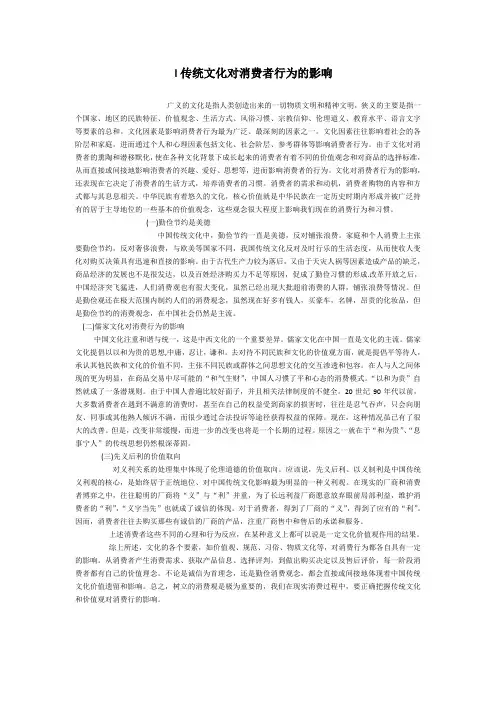
l传统文化对消费者行为的影响广义的文化是指人类创造出来的一切物质文明和精神文明,狭义的主要是指一个国家、地区的民族特征、价值观念、生活方式、风俗习惯、宗教信仰、伦理道义、教育水平、语言文字等要素的总和。
文化因素是影响消费者行为最为广泛、最深刻的因素之一。
文化因素往往影响着社会的各阶层和家庭,进而通过个人和心理因素包括文化、社会阶层、参考群体等影响消费者行为。
由于文化对消费者的熏陶和潜移默化,使在各种文化背景下成长起来的消费者有着不同的价值观念和对商品的选择标准,从而直接或间接地影响消费者的兴趣、爱好、思想等,进而影响消费者的行为。
文化对消费者行为的影响,还表现在它决定了消费者的生活方式,培养消费者的习惯。
消费者的需求和动机,消费者购物的内容和方式都与其息息相关。
中华民族有着悠久的文化,核心价值就是中华民族在一定历史时期内形成并被广泛持有的居于主导地位的一些基本的价值观念,这些观念很大程度上影响我们现在的消费行为和习惯。
(一)勤俭节约是美德中国传统文化中,勤俭节约一直是美德,反对铺张浪费。
家庭和个人消费上主张要勤俭节约,反对奢侈浪费,与欧美等国家不同,我国传统文化反对及时行乐的生活态度,从而使收人变化对购买决策具有迅速和直接的影响。
由于古代生产力较为落后,又由于天灾人祸等因素造成产品的缺乏,商品经济的发展也不是很发达,以及百姓经济购买力不足等原因,促成了勤俭习惯的形成.改革开放之后,中国经济突飞猛进,人们消费观也有很大变化,虽然已经出现大批超前消费的人群,铺张浪费等情况。
但是勤俭观还在极大范围内制约人们的消费观念,虽然现在好多有钱人,买豪车,名牌,昂贵的化妆品,但是勤俭节约的消费观念,在中国社会仍然是主流。
(二)儒家文化对消费行为的影响中国文化注重和谐与统一,这是中西文化的一个重要差异。
儒家文化在中国一直是文化的主流。
儒家文化提倡以以和为贵的思想,中庸,忍让,谦和。
去对待不同民族和文化的价值观方面,就是提倡平等待人,承认其他民族和文化的价值不同,主张不同民族或群体之间思想文化的交互渗透和包容。
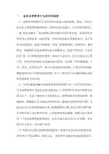
1.东西方消费者行为差异的原因(1)消费者的消费行为受到其所在国家文化的影响。
例如,美国文化具有大量消费资源的特征。
美国经济实力强大,为其消费者提供了广阔的活动舞台。
美国消费心理学家的分析结果表明,美国消费者的基本心理特征是:追赶时髦,不仅对商品内在质量要求高,而且喜欢商品的新奇。
追求自然健康,市场上的健康食品、保健饮料、健身器具、旅游物品等成为消费商品中的新宠儿。
追逐个性档次,人们喜欢按照自己的观念进行消费,表现出与众不同,以充分显示自己的个性;同时对高档商品有较强的购买欲望,从而使一些名牌服饰、手表、珠宝、高档食品等,都占有很高的市场份额。
注重方便有情趣,根据美国生活节奏快速化的趋势,生产厂商开发产品也越来越注意如何使消费者节约时间。
(2)文化的碰撞和融合改变着消费者的消费行为。
在全世界范围内,日本消费者的行为变化是最为剧烈的。
日本消费者在东西方两种文化的冲击下,形成了独特的日本消费方式:消费观念看齐国际标准,新潮商品、新潮购买方式就是典型的代表;储蓄意识保持传统习惯,富裕的日本人仍然坚持勤俭节约,积极储蓄的习惯;购买过程考察严格,在世界市场上有这样的共识:日本消费者最为挑剔;消费目标注重实用,日本的消费者选择商品时,首先考虑它是否对自己有帮助,是否能使自己快乐,是否便于使用。
(3)传统文化深层次控制着消费意识。
欧洲文化向来有高消费传统,消费者由于资金雄厚,购买力高,其消费中表现出明显的喜新厌旧、追求时髦的心理特点,从不满足于已有的商品,总是在丰富多彩的商品中挑选和购买新产品。
他们对消费品的心理需求可以概括为:富有营养、方便食用的食品饮料;张扬个性、引领潮流的服装服饰;设计艺术、色彩和谐的家庭陈设;电子科技、张显档次的家用电器;快速便捷、安全实用的交通工具。
2.东西方消费者行为差异的表现消费社会学把消费看作是一种文化系统,即消费文化。
所谓消费文化,就是伴随消费活动而来的,消费社会学认为,消费受到文化的影响、驱动和制约。
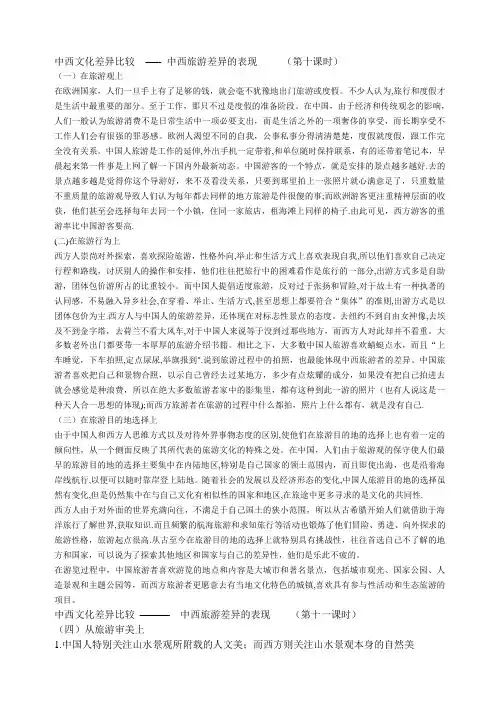
中西文化差异比较-—- 中西旅游差异的表现(第十课时)(一)在旅游观上在欧洲国家,人们一旦手上有了足够的钱,就会毫不犹豫地出门旅游或度假。
不少人认为,旅行和度假才是生活中最重要的部分。
至于工作,那只不过是度假的准备阶段。
在中国,由于经济和传统观念的影响,人们一般认为旅游消费不是日常生活中一项必要支出,而是生活之外的一项奢侈的享受,而长期享受不工作人们会有很强的罪恶感。
欧洲人渴望不同的自我,公事私事分得清清楚楚,度假就度假,跟工作完全没有关系。
中国人旅游是工作的延伸,外出手机一定带着,和单位随时保持联系,有的还带着笔记本,早晨起来第一件事是上网了解一下国内外最新动态。
中国游客的一个特点,就是安排的景点越多越好.去的景点越多越是觉得你这个导游好,来不及看没关系,只要到那里拍上一张照片就心满意足了,只重数量不重质量的旅游观导致人们认为每年都去同样的地方旅游是件很傻的事;而欧洲游客更注重精神层面的收获,他们甚至会选择每年去同一个小镇,住同一家旅店,租海滩上同样的椅子.由此可见,西方游客的重游率比中国游客要高.(二)在旅游行为上西方人崇尚对外探索,喜欢探险旅游,性格外向,举止和生活方式上喜欢表现自我,所以他们喜欢自己决定行程和路线,讨厌别人的操作和安排,他们往往把旅行中的困难看作是旅行的一部分,出游方式多是自助游,团体包价游所占的比重较小。
而中国人提倡适度旅游,反对过于张扬和冒险,对于故土有一种执著的认同感,不易融入异乡社会,在穿着、举止、生活方式,甚至思想上都要符合“集体”的准则,出游方式是以团体包价为主.西方人与中国人的旅游差异,还体现在对标志性景点的态度。
去纽约不到自由女神像,去埃及不到金字塔,去荷兰不看大风车,对于中国人来说等于没到过那些地方,而西方人对此却并不看重。
大多数老外出门都要带一本厚厚的旅游介绍书籍。
相比之下,大多数中国人旅游喜欢蜻蜓点水,而且“上车睡觉,下车拍照,定点尿尿,举旗报到".说到旅游过程中的拍照,也最能体现中西旅游者的差异。
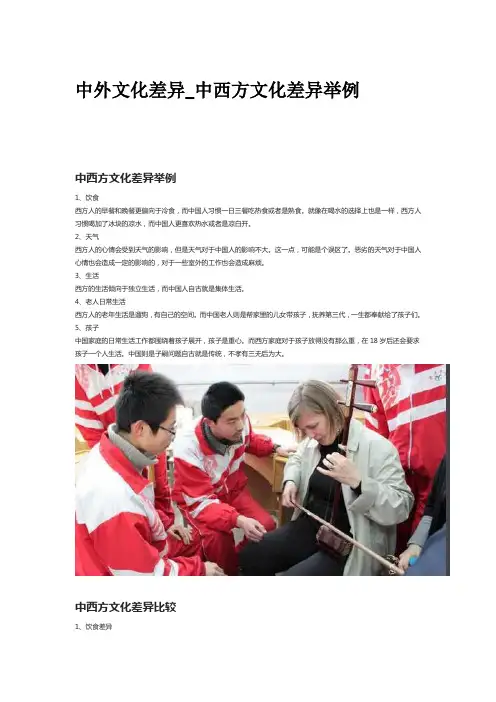
中外文化差异_中西方文化差异举例中西方文化差异举例1、饮食西方人的早餐和晚餐更偏向于冷食,而中国人习惯一日三餐吃热食或者是熟食。
就像在喝水的选择上也是一样,西方人习惯喝加了冰块的凉水,而中国人更喜欢热水或者是凉白开。
2、天气西方人的心情会受到天气的影响,但是天气对于中国人的影响不大。
这一点,可能是个误区了。
恶劣的天气对于中国人心情也会造成一定的影响的,对于一些室外的工作也会造成麻烦。
3、生活西方的生活倾向于独立生活,而中国人自古就是集体生活。
4、老人日常生活西方人的老年生活是遛狗,有自己的空间。
而中国老人则是帮家里的儿女带孩子,抚养第三代,一生都奉献给了孩子们。
5、孩子中国家庭的日常生活工作都围绕着孩子展开,孩子是重心。
而西方家庭对于孩子放得没有那么重,在18岁后还会要求孩子一个人生活。
中国则是子嗣问题自古就是传统,不孝有三无后为大。
中西方文化差异比较1、饮食差异西方是一种理性饮食观念。
不论食物的色、香、味、形如何,而营养一定要得到保证,讲究一天要摄取多少热量、维生素、蛋白质等等。
即便口味千篇一律,也一定要吃下去——因为有营养。
2、观念差异西方人认为一个人只有完全脱离社会关系,真正做到“关注自我”,才能成为一个“真正意义上的人”。
而在中国的文化中,人之所以为人,必须成为社会关系中的一环。
儒家文化中定义:“仁者,人也。
”强调整体和综合。
3、服饰差异西方男士在正式社交场合通常穿保守式样的西装,内穿白衬衫,打领带。
他们喜欢黑色,因此一般穿黑色的皮鞋。
西方女士在正式场合要穿礼服套装。
另外女士外出有戴耳环的习俗。
西方国家,尤其是在美国,平时人们喜欢穿着休闲装,如T恤加牛仔服。
当今中国人穿着打扮日趋西化,传统的中山装、旗袍等已退出历史舞台。
正式场合男女着装已与西方并无二异。
在平时的市井生活中,倒会看到不少人穿着背心、短裤、拖鞋等不合礼仪的服饰。
4、语言差异象形文字强调视觉和闪点,拼音语言强调逻辑和哲学,所以中国文化注重的是写意和系统思维,而西方文化则更多注重抽象和数据。
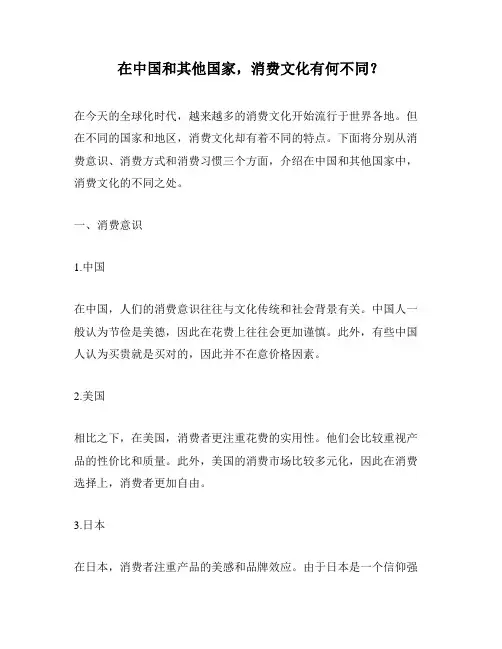
在中国和其他国家,消费文化有何不同?在今天的全球化时代,越来越多的消费文化开始流行于世界各地。
但在不同的国家和地区,消费文化却有着不同的特点。
下面将分别从消费意识、消费方式和消费习惯三个方面,介绍在中国和其他国家中,消费文化的不同之处。
一、消费意识1.中国在中国,人们的消费意识往往与文化传统和社会背景有关。
中国人一般认为节俭是美德,因此在花费上往往会更加谨慎。
此外,有些中国人认为买贵就是买对的,因此并不在意价格因素。
2.美国相比之下,在美国,消费者更注重花费的实用性。
他们会比较重视产品的性价比和质量。
此外,美国的消费市场比较多元化,因此在消费选择上,消费者更加自由。
3.日本在日本,消费者注重产品的美感和品牌效应。
由于日本是一个信仰强烈的国家,因此他们会依据产品的品牌和信仰,来选择自己的消费产品。
二、消费方式1.中国在中国,人们越来越多地选择线上购物。
这主要是因为中国的互联网技术比较发达,因此线上购物成为了中国消费文化的主流。
除此之外,人们也愿意去购物中心,将购物作为一种娱乐和社交形式来体验。
2.美国在美国,人们还比较喜欢去实体店购物。
这是因为在美国,大型的购物商场和超市更多,因此实体店购物成为了美国消费文化中的经典方式。
3.日本在日本,人们比较注重购物体验的质量,因此会更善于寻找一些特色的购物地点,例如独栋商铺、特色小店和风景优美的商业街等。
此外,在日本,福袋也成为一种特色的消费方式。
三、消费习惯1.中国在中国,人们对于特价和优惠的东西比较感兴趣。
很多时候,人们会在网上和实体店寻找打折、降价或赠品等形式的优惠。
此外,中国人也比较喜欢饮茶、吃火锅等休闲娱乐式的消费方式。
2.美国在美国,很多人都喜欢购买有品牌的东西,甚至有些人会认为买名牌是一种身份和地位的象征。
此外,美国人比较注重生活品质,愿意花费钱在健身、旅游等消费上。
3.日本在日本,人们对各类爱好比较热衷。
例如,动漫迷、音乐迷、摄影迷等都会投入大量的资金和精力。
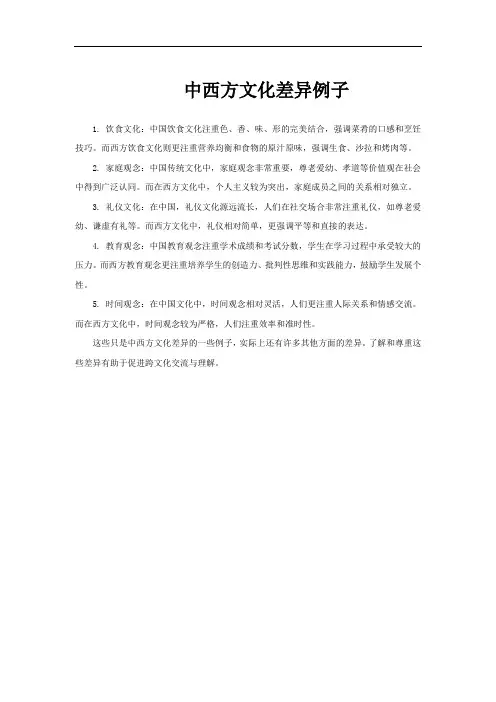
中西方文化差异例子
1. 饮食文化:中国饮食文化注重色、香、味、形的完美结合,强调菜肴的口感和烹饪技巧。
而西方饮食文化则更注重营养均衡和食物的原汁原味,强调生食、沙拉和烤肉等。
2. 家庭观念:中国传统文化中,家庭观念非常重要,尊老爱幼、孝道等价值观在社会中得到广泛认同。
而在西方文化中,个人主义较为突出,家庭成员之间的关系相对独立。
3. 礼仪文化:在中国,礼仪文化源远流长,人们在社交场合非常注重礼仪,如尊老爱幼、谦虚有礼等。
而西方文化中,礼仪相对简单,更强调平等和直接的表达。
4. 教育观念:中国教育观念注重学术成绩和考试分数,学生在学习过程中承受较大的压力。
而西方教育观念更注重培养学生的创造力、批判性思维和实践能力,鼓励学生发展个性。
5. 时间观念:在中国文化中,时间观念相对灵活,人们更注重人际关系和情感交流。
而在西方文化中,时间观念较为严格,人们注重效率和准时性。
这些只是中西方文化差异的一些例子,实际上还有许多其他方面的差异。
了解和尊重这些差异有助于促进跨文化交流与理解。
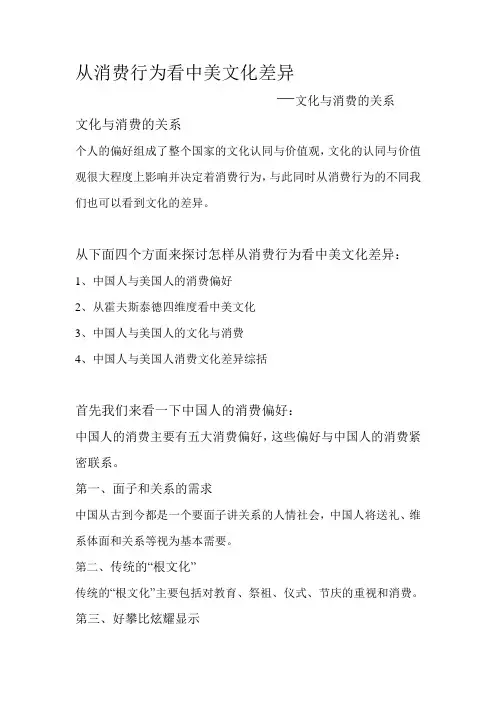
从消费行为看中美文化差异—文化与消费的关系文化与消费的关系个人的偏好组成了整个国家的文化认同与价值观,文化的认同与价值观很大程度上影响并决定着消费行为,与此同时从消费行为的不同我们也可以看到文化的差异。
从下面四个方面来探讨怎样从消费行为看中美文化差异:1、中国人与美国人的消费偏好2、从霍夫斯泰德四维度看中美文化3、中国人与美国人的文化与消费4、中国人与美国人消费文化差异综括首先我们来看一下中国人的消费偏好:中国人的消费主要有五大消费偏好,这些偏好与中国人的消费紧密联系。
第一、面子和关系的需求中国从古到今都是一个要面子讲关系的人情社会,中国人将送礼、维系体面和关系等视为基本需要。
第二、传统的“根文化”传统的“根文化”主要包括对教育、祭祖、仪式、节庆的重视和消费。
第三、好攀比炫耀显示在中国深远的要面子讲关系的文化中,攀比和炫耀显示身份就无疑成为中国人的典型消费特征。
第四、收入较低价格敏感中国经济处于发展中,大多数人收入较低,消费时对价格表现敏感。
第五、物质享受主义中国人注重吃穿住行等物质上的享受,对精神上的享受需求较少。
看完中国人的消费偏好后我们再来看下美国人的消费偏好:美国人的消费偏好主要表现在图上的六大点:第一、赶时髦、猎新奇美国人天性“喜新厌旧”,对旧和老都很忌讳,在消费上追求时髦和新奇。
第二、讲健康、求自然美国人生活水平高,故特别重视对健康的投资;同时美国人生活在一个机械化时代和人造物品的环境中,因而希望返璞归真、回归自然。
第三、追求个性、要高档美国人个性极强,并喜欢在消费生活中表现,并且收入较高,就决定了美国人追求个性要高档的消费特征。
第四、图方便、追求情趣美国是一个高度现代化国家,生活节奏快和忙碌,死板而缺乏情趣,因此消费时对方便和情趣追求要求比较大。
第五、借债消费、超前消费美国拥有完善的信用制度,美国人大部分都是通过借债还债方式进行消费的。
第六、季节性消费美国人消费具有很强的季节性,每个大型节日都是美国市场的销售旺季。
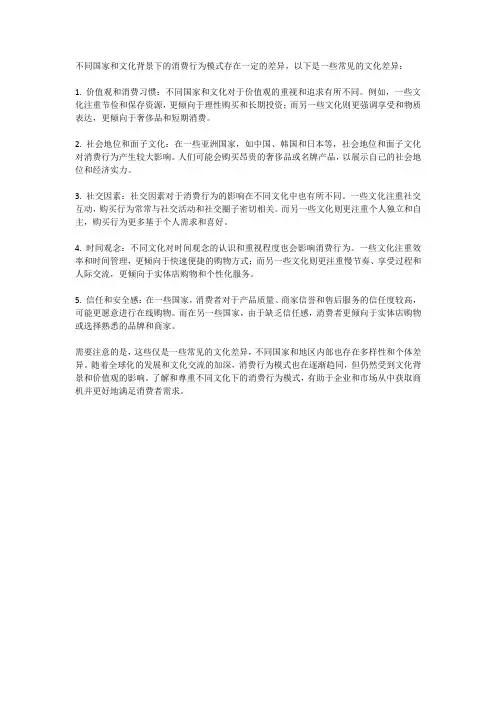
不同国家和文化背景下的消费行为模式存在一定的差异,以下是一些常见的文化差异:
1. 价值观和消费习惯:不同国家和文化对于价值观的重视和追求有所不同。
例如,一些文化注重节俭和保存资源,更倾向于理性购买和长期投资;而另一些文化则更强调享受和物质表达,更倾向于奢侈品和短期消费。
2. 社会地位和面子文化:在一些亚洲国家,如中国、韩国和日本等,社会地位和面子文化对消费行为产生较大影响。
人们可能会购买昂贵的奢侈品或名牌产品,以展示自己的社会地位和经济实力。
3. 社交因素:社交因素对于消费行为的影响在不同文化中也有所不同。
一些文化注重社交互动,购买行为常常与社交活动和社交圈子密切相关。
而另一些文化则更注重个人独立和自主,购买行为更多基于个人需求和喜好。
4. 时间观念:不同文化对时间观念的认识和重视程度也会影响消费行为。
一些文化注重效率和时间管理,更倾向于快速便捷的购物方式;而另一些文化则更注重慢节奏、享受过程和人际交流,更倾向于实体店购物和个性化服务。
5. 信任和安全感:在一些国家,消费者对于产品质量、商家信誉和售后服务的信任度较高,可能更愿意进行在线购物。
而在另一些国家,由于缺乏信任感,消费者更倾向于实体店购物或选择熟悉的品牌和商家。
需要注意的是,这些仅是一些常见的文化差异,不同国家和地区内部也存在多样性和个体差异。
随着全球化的发展和文化交流的加深,消费行为模式也在逐渐趋同,但仍然受到文化背景和价值观的影响。
了解和尊重不同文化下的消费行为模式,有助于企业和市场从中获取商机并更好地满足消费者需求。
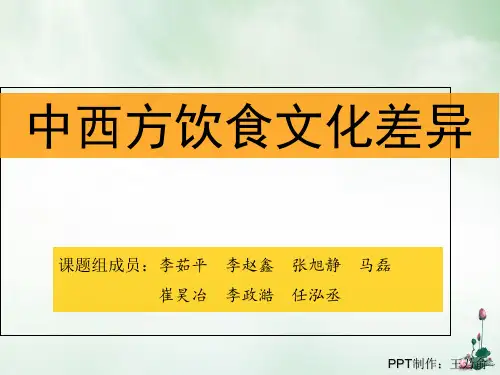

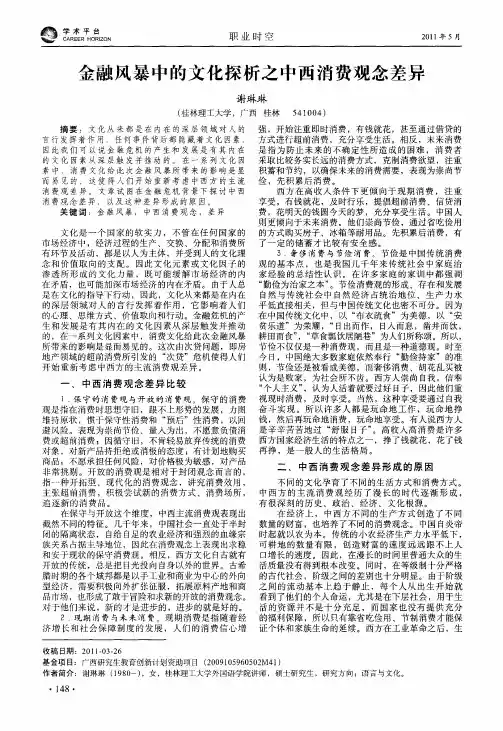
中日消费行为中的文化差异
中日两国拥有着不同的历史、文化和社会背景,这也导致了两国
人民在消费行为方面存在较大的差异。
本篇文章将围绕“中日消费行
为中的文化差异”展开讨论。
第一步,在消费观念方面存在差异。
日本人注重物质与精神的平衡,比如闲余时间的使用、家的氛围、做饭和购物等。
他们更喜欢追
求个性、品味和服务质量。
而在中国,很多人对精神层面的需求并不高,更关注于物质生活,注重的是享受和面子。
另外,在文化教育方面,中国人更加注重传统文化的维护和发展,而日本人则崇尚现代化
和科技。
第二步,消费方式和目的的不同。
在日本,人们通常会更加注重
购物的体验,追求品牌和品质,而且日本人主要的购物场所是大型商
场和专卖店,在这些地方购物,交通、停车、售货员服务等非常方便。
而在中国,消费者更多地采用线上购物或者在超市购买日常所需。
此外,中国消费者在购物时往往更加依靠价格进行决策,对品牌的忠诚
度较低,更追求性价比。
第三步,消费行为文化背景的差异。
在日本,礼仪和谦逊被视为
文化价值观,所以日本人通常会面带微笑、非常有礼貌地表达他们的
需求。
而在中国,消费者普遍表现出更强烈的自我表现欲望,购物时
可能会表现出比较强烈的争抢意识和不太好的行为习惯。
总之,中日消费行为中的文化差异是不可避免的。
因此,了解这
些差异并加以应对,对于开拓中日市场、提高跨国企业的竞争力至关
重要。
中西消费行为调查报告一、调查背景消费行为是人类生活的重要组成部分,也是经济发展的重要推动力。
中西方两大文化背景下的消费行为存在一定的差异,了解并分析这些差异对于企业制定正确的市场策略具有重要意义。
二、调查方法本次调查采用问卷调查的方式,共发放了1000份调查问卷,回收有效问卷850份,有效回收率为85%。
其中500份问卷发放在中国大陆,350份问卷发放在西欧国家。
三、调查结果分析1.消费习惯差异根据调查结果显示,中西两个文化背景下的消费习惯存在一定的差异。
中国大陆的消费者更注重节约,70%的受访者表示会在购物前对价格进行比较,并选择最便宜的商品。
而西欧国家的消费者更为看重品质和品牌,超过60%的受访者表示会更倾向于购买有品牌保证的商品。
这一差异主要源于不同文化对于消费观念的不同看重点。
2.消费动机差异调查数据显示,中西方消费者选择购买商品的动机也存在一定差异。
中国大陆的消费者更注重实用性和功能性,他们购买商品更多是为了满足基本需求。
而西欧国家的消费者更为注重商品的享受和娱乐价值,他们购买商品更多是为了追求个人的快乐和满足情感。
3.消费决策影响因素差异消费者的消费决策受到多方面因素的影响,中西方两个文化背景下,这些因素的重要程度存在差异。
比如,在信息获取方面,中国大陆消费者更多依赖亲友和口碑传播,而西欧国家的消费者更倾向于通过媒体和互联网获取信息。
4.消费态度差异消费态度是指消费者对于购买行为的态度和情感倾向。
调查结果显示,在消费态度上,中国大陆的消费者更注重物质性需求的满足,他们更倾向于购买实用的商品。
而西欧国家的消费者更追求个性化和多样性,他们更注重购买能够体现自我和个体差异的商品。
四、结论与建议通过对中西方消费行为的调查,可以得出以下结论:1.中西方消费习惯和动机存在明显差异,企业在制定市场策略时应根据不同文化背景的消费者需求进行调整;2.消费者的决策影响因素存在差异,企业应根据消费者获取信息的途径和偏好进行精准定位和推广;3.消费者的消费态度存在差异,企业应根据消费者对于商品有不同的态度和情感倾向进行产品差异化设计和宣传推广。
美国和中国的消费文化有何异同?消费文化作为一个国家的文化之一,深刻地影响着人们的生活方式和消费习惯。
美国和中国作为世界上两个最大的消费市场,其消费文化方面的差异引人关注。
本文将从以下几个方面介绍美国和中国的消费文化异同点:一、价值观的差异1. 价值观差异美国和中国的价值观存在较大差异,这体现了两种文化中对消费观念的不同理解。
美国文化中的消费市场被视为经济增长的引擎,而中国则更注重消费行为的道德约束。
美国人普遍认为,通过购买物品来展示个人实力和身份地位是一种正常的消费习惯。
而中国文化强调“节俭为上”,认为消费应该谨慎,不可过分奢侈。
2. 品牌文化品牌文化在美国和中国的消费市场中体现出不同的地位。
美国消费者往往情愿花费较高的价钱购买来自知名品牌的商品,这反映了美国的消费文化追求的是个性化的文化消费体验。
而中国消费市场中则以“性价比”为准则,相对注重性价比更高的商品。
二、消费模式的不同1. 线上销售随着互联网技术的发展,线上销售成为了全球消费市场的重要形式。
对于美国和中国两个消费大国,线上购物渠道的发展也不尽相同。
在美国,电商巨头亚马逊和沃尔玛等零售商占据了主要的线上销售市场。
而在中国,电商平台阿里巴巴旗下淘宝和天猫则成为了重要线上销售渠道。
2. 服务业消费这方面,则体现了两国经济质量不同的差异。
在美国,服务业占据了主导地位,大多消费者更愿意为高质量的服务买单。
而在中国,由于经济产业结构还尚未完全转型,以服务业为主导的消费市场基础不够稳定。
三、消费行为的差异1. 消费场景的区别美国和中国消费场景的差异,从某种程度上反映了两国不同的生活方式和消费倾向。
在美国,消费市场主要集中在购物中心等线下销售场景中,开车到店铺购物是一种常见的消费行为。
而在中国,购物中心与电影院、餐厅等多种消费场景集成为复合式消费中心,强调的是全场地复合式消费体验。
2. 社交消费与个人消费的差异在美国,社交消费比较普遍,由于强调个性化体验,所以社交性消费也更注重于社交场景的体验感。
不同文化对于消费习惯有何不同,以及为何会有这种不同?消费习惯是一个国家或地区的经济和文化背景下的产物,受到地理、宗教、历史、社会结构等多方面的影响。
因此,不同文化对于消费习惯具有明显的差异。
下面就具体来谈谈不同文化背景下的消费习惯所存在的不同之处。
一、亚洲文化亚洲国家是老祖宗文化的重要代表,以中国、日本等东亚国家的文化最为突出。
在东亚国家中,传统的家庭观念非常强烈,家庭的经济实力决定了家庭生活水平,因此节俭是他们的主要消费特征。
在他们的日常生活中,穿着朴素、饮食节制、家居环境清新简洁。
东亚国家的传统文化注重礼仪,所以礼品文化相当发达,比如春节期间糖果、水果、猪蹄等常见的礼品。
此外,东亚国家个人主义不如西方国家,家庭和社区关系相比较重要。
二、欧美文化欧美国家的文化互为对立。
在欧洲,传统的经典文化经济相对单薄,而且民主自由、个人追求幸福的代表性文化活力十分旺盛。
因此,欧洲国家普遍拥护高品质的商品,他们比较注重商品的质量,而不是商品的价格。
购物不仅仅是为了满足自己的需求,更是一种生活方式。
欧洲人注重食品的品质,比如西班牙的火腿、希腊的沙拉等都是很畅销的食品。
美国是个多元文化的国家,产生了很多消费文化,比如漫画、卡通等都是美国的消费文化。
在美国,消费者购买商品时非常注重品牌和外观,因此许多品牌手袋、服装等都是非常受欢迎的。
三、中东文化中东被称为世界上最富有的地区之一,消费文化也因此迥异于其他地区。
中东的消费特点主要表现在豪华、贵重上。
中东国家的人们非常注重宗教仪式和传统节日,因此他们对珠宝、黄金等奢侈品的需求成倍增加。
在穆斯林文化中,土地和家庭是极为重要的,家庭和朋友聚会时,在饮食方面更是尽情享受。
同时,穆斯林文化具有一定的性别差异,男女在消费方面具有差异性,男性主导家庭的经济,因此决定了他们在商场上的购物决策权。
四、非洲文化非洲地区经济比较欠缺,社会发展比较缓慢,因此非洲地区的消费文化比较单一,主要是食品和衣服。
中西文化差异——消费差异
由于美国的次贷危机引发的金融危机,中西方消费观的差异再次被搬上了人们的前面,西方的超前消费和中国的保守消费展开了新一轮的“较量”。
大家应该都听说过这样一个老生常谈的故事了吧!其中讲的是中美两国人在消费观念上的不同。
在天堂相遇的一个中国老太太和一个美国老太太,谈起了在人间的一生。
美国老太太说:“我辛苦了三十年,终于把住房贷款都还清了。
”中国老太太说:“我辛苦了三十年,终于攒够了买房的钱。
”美国老太太在自己买的房子里住了三十年,后半生都在还款;而中国老太太后半生一直在存款攒钱,刚攒够了买房的钱,却去了天堂,无福享受自己买的新房。
由此明显看出,美国人早已习惯贷款消费,而中国人大多喜欢存款消费。
在美国,贷款消费无处不在。
超前消费顾名思义就是拿你将来可能挣到的钱用来今天消费。
最典型、最普遍的超前消费形式就是银行贷款消费。
美国人的超前消费行为是出了名的,到银行贷款就像是到邮局发封平信一样,是家常便饭。
买房子贷款、上大学贷款、买汽车贷款、买台电脑贷款、甚至有人买台微波炉、买部电话都要贷款。
超前消费的另外一种形式就是信用卡消费,有人就是想利用银行信用卡的30天免还期透支消费,然后用新贷还旧贷,结果背上一身卡债。
在一定程度上,贷款超前消费确实有其好处,一方面消费者在一下子拿不出那么多钱的情况下可以通过贷款提前享受自己所期望的生活;另一方面,它又可以刺激消费,从而刺激经济增长。
在经济繁荣时期,这固然是好的,然而在经济萧条时期,尤其是在金融危机时期,次贷危机在众多消费者毫无准备的情况下一下子铺天盖地而来,其严重的负面后果就显现出来。
中国接受的思想是儒家的勤俭之道。
“谁知盘中餐,粒粒皆辛苦”,已经成为了老幼皆知,共同认可的理念,一茶一饭,当思来之不易的古训深入人心。
大家在消费上量入为出,不会为了某一项消费而倾囊,特别是不是生活必须的消费,如果是住房当然另当别论。
在中国人眼里,这即是固定资产投资,也是收益性投资,尤其是在现在。
买房买地这是几千年中国人的治家之道。
首先,中国消费者不大量举债。
“其他地方的消费者变富后喜欢买更昂贵商品”,“有人开始依赖贷款,入不敷出”。
这种情况在中国没有。
中国的消费者非常关注收支稳定,在花钱上量力而行。
其二,为控制肆意消费,如果他们在某些方面“花费过多”,就会在其他方面“找回来”。
例如许多人为了给客户或同行留个好印象,在个人打扮上花钱较多,但大多会在生活中得替他方面上少花费以平衡支出。
中国人先预算再购物(甚至根本就不买了)。
典型的中国家庭会先算好花得起多少钱,再列出想买的清单,最后通过“选美比赛”决定单子上的哪些产品最具吸引力。
他们花费数月时间研究需购商品。
例如许多中国家庭为购买一台电脑,会话一定时间决定买哪种型号。
很多人逛商店也只是看,但并不买任何东西。
中西消费观念的差别取决于传统文化和伦理价值的差别,消费习惯间的差异不能说明优劣之分,但随着中西文化的交流和融合,中国人在为子孙积聚财富的同时,也在接受贷款消费。